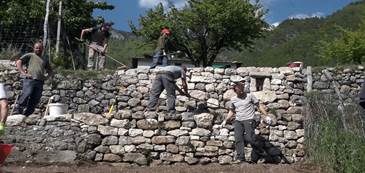Inscribed in 2018 (13.COM) on the Representative List of the Intangible Cultural Heritage of Humanity
1.1 Description of the element
The art of dry stone walling concerns the knowhow related to making stone constructions by stacking stones upon each other, without using any other materials except sometimes dry soil. Dry stone structures are spread across most rural areas – mainly in steep terrains – both inside and outside inhabited spaces, though they are not unknown in urban areas. The stability of the structures is ensured through the careful selection and placement of the stones, and dry-stone structures have shaped numerous, diverse landscapes, forming various modes of dwelling, farming and husbandry. Such structures testify to the methods and practices used by people from prehistory to today to organize their living and working space by optimizing local natural and human resources. They play a vital role in preventing landslides, floods and avalanches, and in combating erosion and desertification of the land, enhancing biodiversity and creating adequate microclimatic conditions for agriculture. The bearers and practitioners include the rural communities where the element is deeply rooted, as well as professionals in the construction business. Dry stone structures are always made in perfect harmony with the environment and the technique exemplifies a harmonious relationship between human beings and nature. The practice is passed down primarily through practical application adapted to the particular conditions of each place.
1.2 Geographical location and Range of the element:
Croatia, Cyprus, France, Greece, Italy, Slovenia, Spain and Switzerland.
Closely depending on the geomorphology of each area, the availability of resources, and the functional needs, dry stone structures are spread over most rural areas, both inside and outside inhabited spaces, although they are not unknown in urban areas. They are mainly found in steep terrains, hillsides and mountain feet, but they are not absent from plateaus, depressions and valleys. Dry stone structures characterise hinterland and coastal areas as well as continental and island zones; they constitute a prevailing feature of the landscape in all submitting States. The stones used in the various structures are always found locally.
The element constitutes a major feature of the landscape all over Cyprus, France, Greece and Slovenia, although it is more prevalent in the wine-producing villages of the Troodos mountain range (Cyprus), in the Aegean and Ionian Islands and Epirus and Peloponnese regions (Greece) and in Karst and Istria regions (Slovenia).
In Croatia, dry stone is strongly manifested in the Adriatic-Dinaric belt (Istria, Primorje and Dalmatia regions).
In Italy, dry stone constructions appear in many different regions. A non-exhaustive list of locations includes in the North: Lombardia (Valtellina), Piemonte (Val d’Ossola), Liguria (Cinque Terre), Friuli Venezia Giulia (Carso triestino, Carso goriziano), Valle d’Aosta, Trentino Alto Adige and Veneto (Val Posina, Val d’Astico); in the middle: Toscana (Colline del Chianti) and Lazio (Vallecorsa); in the South: Campania (Costiera amalfitana), Sicily (Monti Iblei, Pantelleria), Calabria (Costa Viola), Puglia (Valle d’Itria) and Sardinia (Ogliastra).
In Spain, examples of this technique can be found throughout the country, especially in the Autonomous Communities of Andalusia, Aragon, Asturias, Balearic Islands, Catalonia, Extremadura, Galicia and Valencia.
In Switzerland, the technique has a pronounced impact on rural and altitude landscapes, most notably in the Jura Mountains (North-Western Switzerland), the Alps (Southern Switzerland) and the Southeastern part of the country.
It must be noted that the element is also practised in many other places and countries of the world and could be characterised as a universal feature of human interaction with natural environment.
1.3 Domain(s) of the element
Domain(s) of the element as intangible cultural heritage identified according to the Article 2.2 of the Convention:
- oral traditions and expressions, including language as a vehicle of the intangible cultural heritage
- performing arts
- social practices, rituals and festive events
- knowledge and practices concerning nature and the universe
- traditional craftsmanship
- Other(s): (children’s games: “volti”, a game played by children in certain regions of Greece, where teams of children compete with each other in building miniature dry stone constructions)
Evaluation Body Decision
Iscrizione: 13.COM 10.B.10
